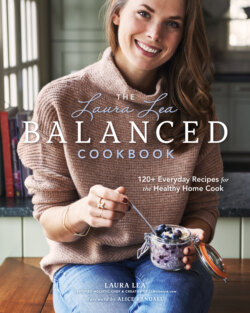Читать книгу The Laura Lea Balanced Cookbook - Laura Lea - Страница 29
На сайте Литреса книга снята с продажи.
Оглавлениеhave been shown to improve cardiovascular
and cholesterol health. While you may enjoy
them raw (kudos), they’re divine cooked up
and softened in some good fat. A tip I learned
from integrative oncologist Dr. Santosh Rao is
to allow garlic to sit 10 minutes after mincing
and before combining with something acidic,
as this allows for the conversion of beneficial
compounds. Also, when mincing garlic, first
slice in half vertically to see if there’s a green
stem in the middle. If so, remove this garlic
“germ”; it has a bitter flavor.
• Non-starchy colorful vegetables. And this is
the lovely category of everything in between!
This includes bell peppers and other
peppers, turnips, asparagus, artichokes,
celery, eggplant, jicama, sugar snap peas,
green beans, pumpkins, cucumbers,
zucchini, summer squash, and tomatoes
(which are technically a fruit but are
generally viewed as a veg). All are gloriously
nutritious and delectable in their own right,
and I urge you to play around with different
ways to enjoy them.
Gorgeous fruit: My husband and I usually
prefer to eat fruit as a snack or with breakfast,
and I enjoy several servings every day. Fruit
is nature’s candy, as scrumptious as it is
beautiful to look at. Most fruits are fiber
powerhouses, and each variety contains its
own rainbow of vitamins and minerals. Some
fruits are higher in sugar than others, so I’ve
categorized them according to their sugar
content. This is not a prescription for how
much is too much—that’s up to your body.
However, it is worth understanding that fruit
can have a significant impact on your blood
sugar. When cutting dried fruit, rubbing a thin
layer of oil on a knife before cutting makes it
much easier and faster.
• Low-sugar fruits. Blackberries, cranberries,
raspberries, avocado (indeed, it is a fruit!),
lemons, limes, and rhubarb
• Moderate-sugar fruits. Strawberries,
blueberries, watermelon, nectarines,
peaches, papaya, apples, grapefruit,
honeydew, cantaloupe, and apricots
• High-sugar fruits. Pineapple, banana,
mango, plums, pears, oranges, kiwis,
cherries, figs, and dried fruit
Allergy versus Intolerance
versus Sensitivity
GLUTEN
I know your head is probably spinning from
the gluten-free bug that’s swept the nation in
the past several years, but here’s the deal with
gluten. Gluten is a protein found in certain
grains like wheat, barley, rye, and spelt. People
who have celiac disease cannot tolerate even
a speck of gluten because it will cause their
bodies to start to attack its own tissue. Celiac
disease affects only a small percentage of
the population, but allergies, sensitivities,
and intolerances to gluten are much more
common. Allergy symptoms tend to show
up immediately after ingesting a food, in the
form of hives or rashes, difficulty breathing,
nausea and vomiting, and irritation of the
throat or mouth. A gluten allergy doesn’t
tend to cause the same amount of long-term
damage to the intestines as celiac disease.
Intolerances or sensitivities are more difficult
to diagnose, because the symptoms can
appear more slowly. Usually, these symptoms
include mental and physical fatigue, digestive
upset such as bloating or constipation,
and headaches. If you experience any of
these, I suggest working with a health-care
professional to cut gluten out of your diet for
Cruciferous
vegetables,
like cabbage,
kale, Brussels
sprouts, and
radishes, are a
fantastic defense
against chronic
inflammation.
